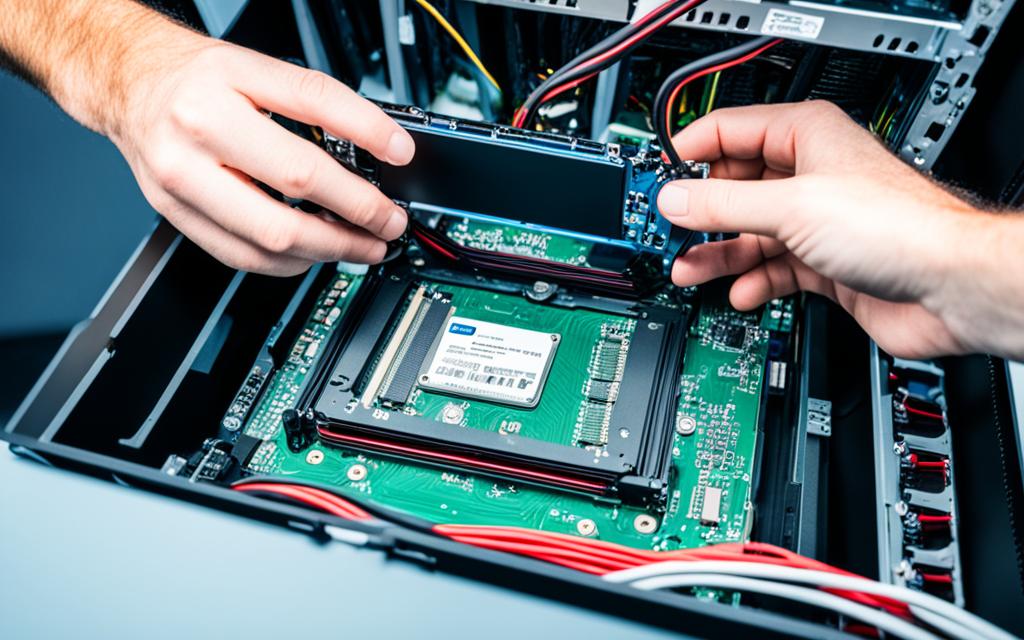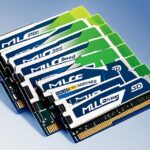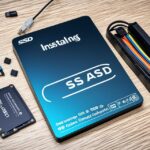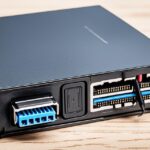Table of Contents
In our fast-paced digital age, learning to install Windows on an SSD is key. Moving your operating system to an SSD not only boosts performance but also improves boot times and durability. No matter your experience level, this guide will walk you through installing Windows or moving your OS to an SSD.
The entire setup takes about 30-45 minutes for a fresh install, and 25-30 minutes for a migration1
Key Takeaways
- Installing Windows on SSD can greatly improve overall system performance.
- SSDs provide faster boot-up times and smoother performance due to quicker access times2.
- Proper preparation is essential, including backing up important data and ensuring the SSD is formatted2.
- Two common methods for SSD installation are a clean install and cloning your existing setup2.
- Choosing the right software can streamline the process, such as EaseUS Partition Master for migration1.
- Understanding the benefits of SSDs, including durability and reduced noise, enhances your decision3.
- Maintaining an optimal workflow includes ensuring your installation media is ready, typically a USB of at least 8 GB3.
Understanding the Benefits of Installing Windows on an SSD
Putting Windows on a solid-state drive (SSD) has some clear benefits of SSD over using hard disk drives (HDDs). The main advantage is the big boost in Windows performance. Let’s look at the top benefits of this choice.
Improved Performance
Thanks to their advanced tech, SSDs leave HDDs in the dust. They provide faster read and write speeds. This leads to quicker system response and shorter loading times. Apps open more quickly, and you can do more at once without slowing down, thanks to the real SSD advantages43.
Faster Boot Times
One impressive advantage is how fast Windows starts on an SSD. Many find their systems boot in less than 20 seconds. This quick access to your desktop or apps boosts your productivity5.
Enhanced Durability
SSDs are more durable because they don’t have moving parts. This means they’re better at handling drops and knocks. Their long-lasting nature and lower chance of failure are perfect for gadgets on the go. Plus, your data stays safe longer, giving you extra confidence in your SSD choice3.
For detailed steps on installing Windows on a new machine, check the full guide here: link.
| Feature | HDD | SSD |
|---|---|---|
| Speed | Slower read/write speeds | Much faster read/write speeds |
| Boot Time | Varies, often longer | Under 20 seconds |
| Durability | Moving parts increase risk of failure | No moving parts increase shock resistance |
| Noise Level | More noise due to moving parts | Quiet operation, minimal noise |
Preparing for Installation
To ensure a smooth Windows installation on an SSD, getting everything ready is key. You need to protect your data and pick the right SSD for your setup.
Backup Your `Data
First, back up your data thoroughly. This step keeps your important info safe from loss. It’s vital for a stress-free setup process. Maintaining regular backups is crucial for any system upgrade or move56.
Choosing the Right SSD
When choosing an SSD, think about storage size and speed. SSDs vary in shape and special benefits, such as 2.5”, M.2, and PCIe types. Make sure the SSD fits with your computer’s motherboard.
Connect the SSD correctly, either through a SATA connection or in its special slot. Then, set it up for Windows by initialising it as MBR or GPT. The right SSD can make your computer faster and start quicker.
How to Install Windows to an SSD
Installing Windows on an SSD boosts your computer’s speed and shortens boot times. You can do a clean installation or migrate from your current system. To begin a clean install, create Windows install media on a USB to start the Windows installation process.
For migration, use tools like EaseUS Partition Master or AOMEI Partition Assistant. Make sure your new SSD is big enough, so you don’t run into space issues7. SSDs are becoming standard due to their speed, showing their value in modern computing7.
Check how to physically install your SSD first. Desktops might let you add multiple drives, but single-drive systems need special steps. Laptops might need extra tools for the job7. Once in, adjust the BIOS/UEFI settings to boot from the SSD. Skipping this step might cause issues8.
Installing Windows can face hurdles, like the SSD not being detected. This often comes from old BIOS settings or connection errors8. Knowing these challenges helps for a smooth switch to your new SSD. It maximises the advantages of your clean installation.
Using Windows Installation Media
The journey of installing Windows on your SSD starts with Windows installation media. This method uses a bootable USB drive for quick and smooth installation. Here are the main steps to create the USB drive and begin the installation.
Creating a Bootable USB Drive
First, download the Windows Media Creation Tool from Microsoft’s site. Open the tool and select the option for creating installation media for another PC. You’ll choose your language, architecture, and Windows edition. Make sure you have a USB drive with at least 8GB. It’s needed to hold the Windows installation files9.
Installing Windows from USB
After preparing the USB drive, plug it into your PC. Then, restart your machine and access the BIOS settings. Set the USB as the primary boot device. Your PC will guide you through the setup. It will ask for your digital license key and let you pick settings. This makes the Windows installation on your SSD tailored and efficient9.
| Step | Description |
|---|---|
| 1 | Download the Media Creation Tool from Microsoft’s website. |
| 2 | Select “Create installation media for another PC.” |
| 3 | Choose language, architecture, and edition. |
| 4 | Insert a USB drive of at least 8GB capacity. |
| 5 | Restart the computer and access BIOS to set USB as the primary boot device. |
| 6 | Follow on-screen prompts to install Windows on the SSD. |
This method gets rid of the need for a DVD drive, making the installation smoother. For help on cloning your current installation, check out MiniTool’s migration tips.
Cloning Your Existing Windows Installation
Cloning your Windows setup is a smart choice for moving everything to a new solid-state drive (SSD). It lets you avoid the hassle of starting over. By using the right methods and tools, you can significantly boost your system’s speed when you move everything to an SSD.
Choosing Cloning Software
It’s crucial to pick the best software for cloning your Windows. Options like EaseUS Disk Copy and MiniTool Partition Wizard are easy to use and powerful. EaseUS Disk Copy, for instance, makes the whole process simpler. It works well with different disk types and makes, which suits most users10. It also checks storage space while cloning, highlighting any space issues on the new SSD11.
Step-by-Step Cloning Process
Starting the cloning process involves a few easy steps. First, set up the cloning software on your computer. Then, choose the clone option, picking your old hard drive as the source and the new SSD as the target. You might need to adjust the size of the partitions, especially if your new SSD is smaller than your old HDD. This step is key if you’re moving from a larger HDD to a smaller SSD.
After getting everything ready, start cloning. When it’s done, go into your BIOS settings. Make the SSD your primary boot drive. This boosts your system’s performance and speeds up starting up10. By following these instructions, not only do you transfer Windows to an SSD, but you also enjoy quicker boot times and a more efficient system.
Configuring BIOS for SSD Boot
After you’ve installed or cloned Windows to your SSD, setting up the BIOS is next. This key step makes sure your SSD is the main boot drive. It boosts both performance and reliability.
Entering BIOS Setup
To start, reboot your computer and quickly enter BIOS by tapping F2, Del, or Esc, depending on your motherboard. You’ll then see the BIOS screen where you can adjust settings. To activate your SSD in the BIOS is simple: restart your PC, hit the right key to enter BIOS, find the setup, switch on the SSD, then save and exit12.
Setting SSD as Boot Drive
In the BIOS menu, look for the boot options. Choose your SSD as the top boot device. This might take around 3-5 minutes13. Remember to save your new settings before you leave the BIOS. When you restart your PC, it will boot from the SSD first. Having the SSD as your boot drive speeds up boot times and makes your computer quicker14.
Conclusion
Putting Windows on an SSD is a major boost for any PC, given it really speeds things up compared to old HDDs. SSDs work almost 100 times faster, so starting your computer and opening programs is much quicker. This makes your work smoother and your computer time more enjoyable1516.)>
SSDs are also tougher because they have no moving parts. This means they’re better at handling bumps and shakes, which is great for regular use or for more intense tasks15. You can choose to start fresh with a new Windows install or move your current setup. Tools like AOMEI Partition Assistant Professional15 are recommended by experts for this.
Making the move to an SSD is definitely worth it. Whether you’re setting up Windows from scratch or copying your old system, you’ll notice a big difference. Investing in an SSD is a wise choice for anyone looking to improve their computer’s performance16.
FAQ
What are the benefits of installing Windows on an SSD?
Installing Windows on an SSD has many advantages. You’ll see better performance and faster boot times. An SSD is also more durable against shocks than an HDD. This results in quicker access to apps and improved multitasking.
How do I prepare for the installation of Windows on an SSD?
Before you start, back up your data to avoid any loss. Choose the right SSD for your system’s needs. Make sure the SSD is properly installed and set up for your computer.
Can I clone my existing Windows installation onto an SSD?
Yes, cloning your current Windows to an SSD is possible. Use cloning software like EaseUS Partition Master or AOMEI Partition Assistant. This lets you move your entire system without a clean install.
What is the procedure for creating a bootable USB drive for Windows installation?
To make a bootable USB, first download the Windows Media Creation Tool from Microsoft’s website. Run the tool and choose “Create installation media for another PC”. Follow the instructions to pick your options. Make sure your USB has at least 8 GB of space.
How do I configure the BIOS after installing Windows on my SSD?
After installing, restart your PC and open the BIOS setup with the right key (often F2, Del, or Esc). In the BIOS, go to boot options and choose your SSD as the main boot device. Save your changes and exit.
What should I do if I encounter issues during SSD installation?
If you have problems, check the SSD connection and setup. Make sure your BIOS recognises the SSD. Also, verify your installation media works with your system. If issues continue, look for help in the support pages for your SSD or installation software.
What is the difference between a clean installation and migration?
A clean installation means setting up Windows anew on your SSD. A migration moves your current system and files from an old drive. Your needs will determine the best choice. Clean installs are good for a fresh start, while migration keeps everything you have.
Source Links
- https://www.easeus.com/partition-master/install-windows-10-on-ssd.html – How to Install Windows on SSD via 2 Easy Ways 🏆
- https://www.ubackup.com/windows-10/install-windows-10-to-ssd.html – Directly Install Windows 10 on New SSD with/without CD | 2 Ways
- https://www.diskpart.com/windows-10/install-windows-10-on-ssd-4348.html – How to Install Windows 10 on SSD Easily and Successfully
- https://www.diskpart.com/questions/should-i-install-windows-on-ssd-or-hdd-0001-gc.html – Should I Install Windows on SSD Or HDD?
- https://www.wps.com/blog/how-to-install-windows-1011-on-new-solid-state-drive-ssd-in-easy-steps/ – How to Install Windows 10/11 on New Solid State Drive(SSD)? (In Easy Steps) | WPS Office Blog
- https://www.partitionwizard.com/clone-disk/install-windows-10-on-new-ssd-without-usb.html – Install Windows 10 on New SSD Without USB with 2 Methods
- https://www.pcmag.com/how-to/copy-your-windows-installation-to-an-ssd – How to Copy Your Windows Installation to an SSD
- https://www.partitionwizard.com/clone-disk/cant-install-windows-11-on-ssd.html – Can’t Install Windows 11 on SSD Fix Tutorial [New Update]
- https://www.partitionwizard.com/partitionmanager/install-windows-10.html – How to Install Windows 10 on a New Hard Drive (with Pictures) – MiniTool Partition Wizard
- https://www.pcworld.com/article/1995663/clone-windows-10-to-ssd-without-reinstalling-everything-2.html – Clone Windows 10 to SSD Without Reinstalling Everything
- https://www.partitionwizard.com/clone-disk/migrate-windows-10.html – Easily Migrate Windows 10 to SSD Without Reinstalling OS Now! – MiniTool Partition Wizard
- https://www.solidigm.com/support-page/installation-compatibility/ka-00046.html – Converting A Data Solid State Drive Or SSD With Windows* Installation From Legacy To UEFI Without Data Loss
- https://www.easeus.com/partition-master/set-ssd-as-boot-drive.html – How to Set SSD as Boot Drive [2024 Updated]
- https://learn.microsoft.com/en-us/windows-hardware/manufacture/desktop/windows-setup-installing-using-the-mbr-or-gpt-partition-style?view=windows-11 – Windows Setup: Installing using the MBR or GPT partition style
- https://www.diskpart.com/articles/how-to-install-windows-on-new-ssd-laptop-1503.html – How to Install Windows on New SSD Laptop [Easy Guide]
- https://www.passfab.com/partition-manager/install-windows-10-on-new-ssd.html – Step-by-step Guide on How to Install Windows on New SSD








